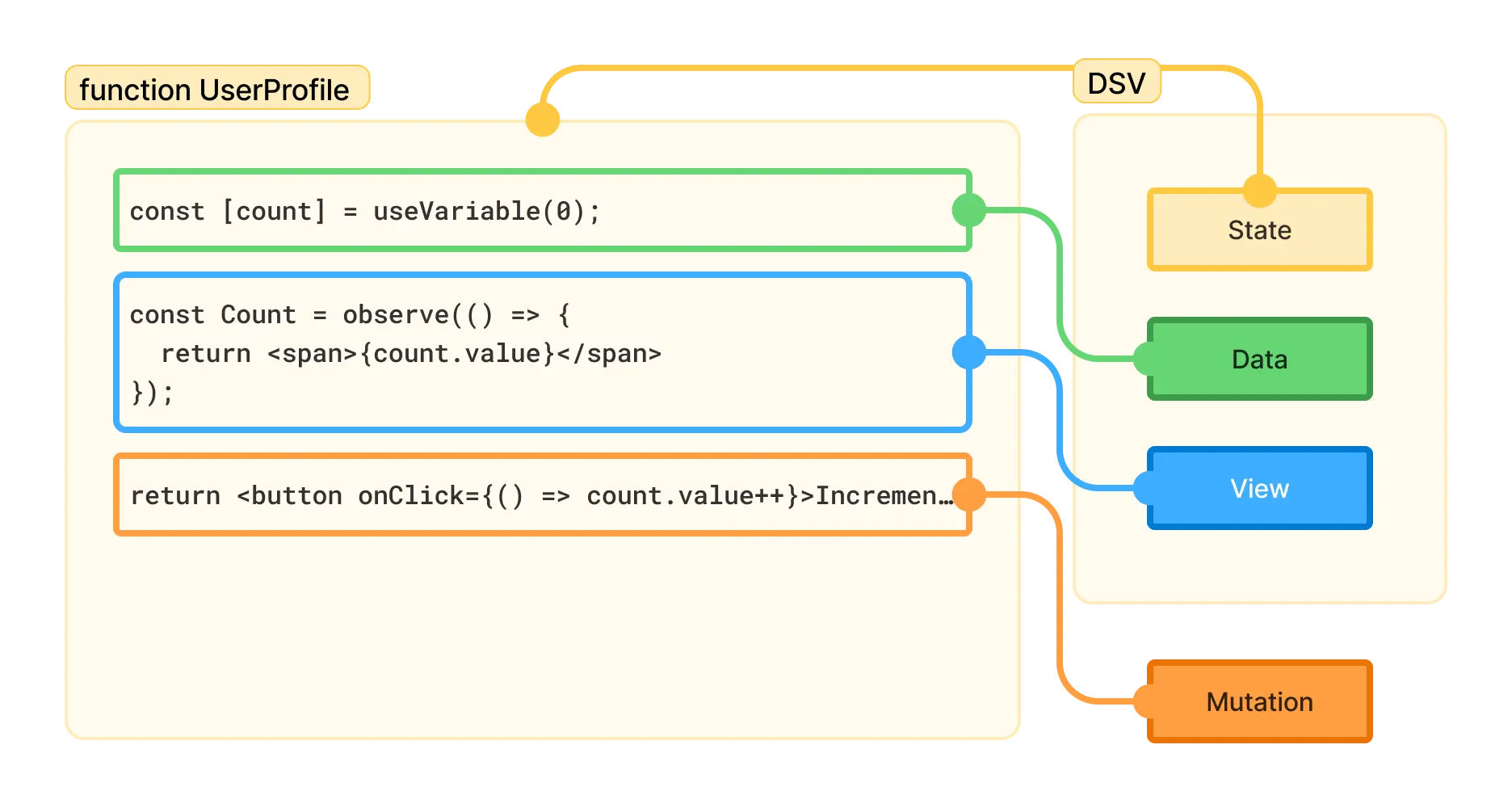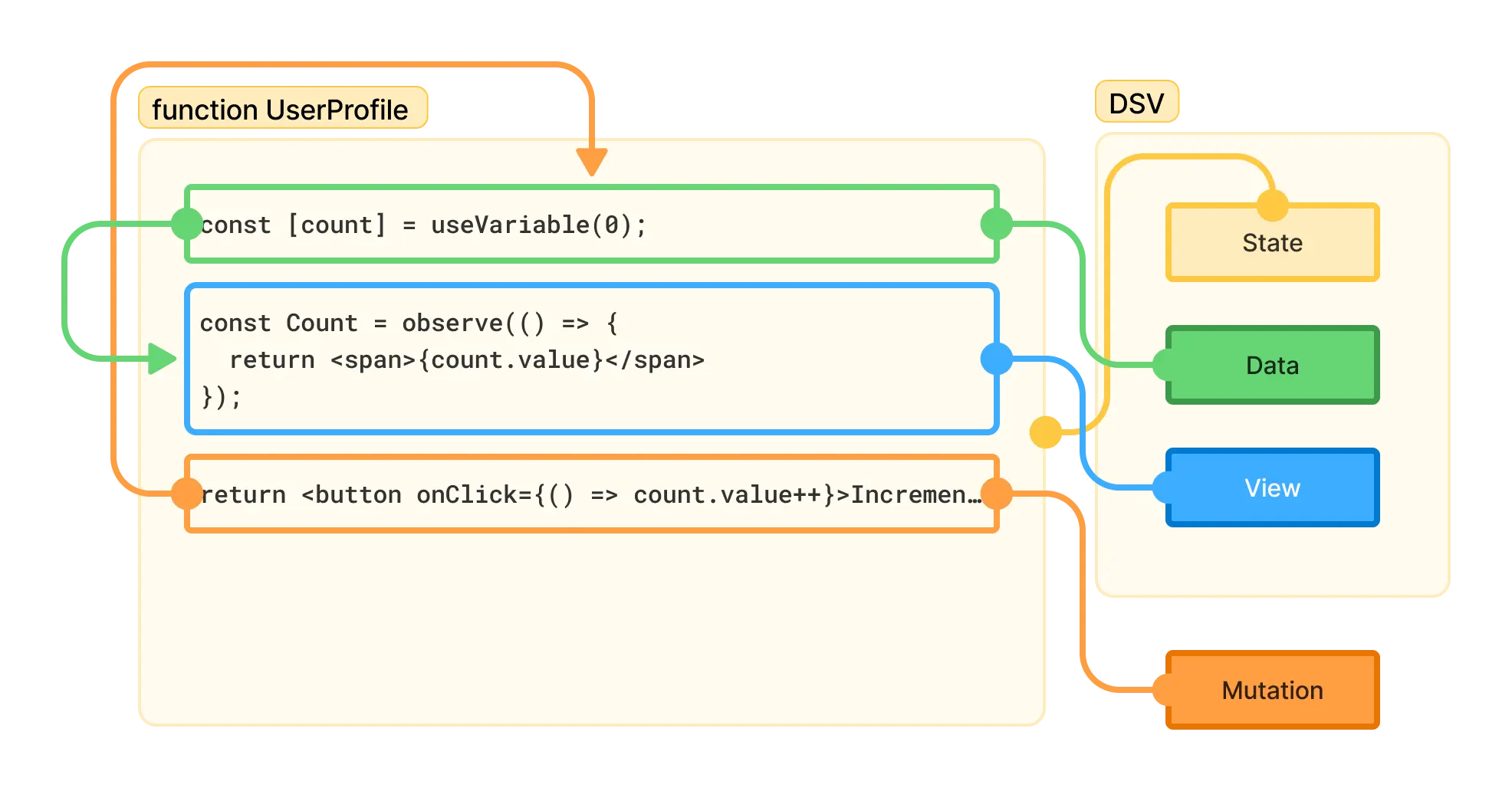Reactivity in Anchor for React
Anchor redefines reactivity in React by providing a more intuitive and efficient approach to state management that aligns with how developers naturally think about UI components.
Unlike traditional React where components re-render whenever their state change, Anchor uses granular reactivity system where only the parts of your UI that actually depend on changed data are updated.
Anchor's Reactivity
Anchor introduces a fundamentally different approach to reactivity that eliminates these issues by separating concerns and providing granular control over rendering through the DSV (Data-State-View) pattern.
The DSV (Data-State-View) Pattern
Anchor promotes the DSV pattern that clearly separates responsibilities:
Data: Reactive state objects that hold your application data.State: Components that manage state but doesn't re-render.View: Small components that observe specific state changes and re-render efficiently.

This pattern allows for more efficient rendering because only the View components that actually depend on changed data need to re-render, while the State components that manage the data remain stable, all with code that is easy to reason about and feels natural.
Anchor's DSV Example
// State Component - Renders only once.
const CounterManager = () => {
// Data - reactive state that holds your application data.
const [count] = useVariable(0);
// This variable is stable because the CounterManager itself doesn't re-render.
let renderCount = 0;
// Expensive computation only runs once.
const expensiveValue = computeExpensiveValue();
// View - only re-renders when the observed data changes.
const Count = observe(() => {
// Assignment to local variable works as normally would.
renderCount++;
return (
<>
<h1>Count: {count.count}</h1>
<p>Render Count: {renderCount}</p>
<p>Expensive Value: {expensiveValue}</p>
</>
);
});
// Mutation - Directly mutates the reactive state.
useEffect(() => {
setInterval(() => {
count.count++;
}, 1000);
}, []);
// Reset works as we normaly expect.
const reset = () => {
count.value = 0;
renderCount = 0;
};
return (
<div className="w-full max-w-md mx-auto">
<Count />
<button onClick={reset}>Reset</button>
</div>
);
};Reactivity Lifecycle
Anchor's reactivity follows a clear lifecycle that optimizes performance and predictability:

1. Initialization
During initialization, the State Component creates reactive state objects. This happens only once, or when the parent component re-renders (creating a completely new instance). The state object is created with all its initial values and is ready to be observed by the View components.
State Initialization
const CounterManager = () => {
const [count] = useVariable(0);
let renderCount = 0;
const expensiveValue = computeExpensiveValue();
};2. Observation
In the observation phase, View Components declare what state they depend on. Anchor automatically tracks these dependencies using a sophisticated observer system. When a View component renders, Anchor monitors which state properties are accessed and creates a dependency map.
State Observation
const Count = observe(() => {
renderCount++;
return (
<>
<h1>Count: {count.count}</h1>
<p>Render Count: {renderCount}</p>
<p>Expensive Value: {expensiveValue}</p>
</>
);
});3. Mutation
State mutations in Anchor happen directly and immediately, without waiting for React's render cycle. When you modify a state property, the change is applied instantly to the underlying data structure. You get predictable, synchronous state updates that make it easier to reason about your application's behavior.
State Mutation
setInterval(() => {
count.count++;
}, 1000);
const reset = () => {
count.value = 0;
renderCount = 0;
};4. Re-render
Only the specific View Components that depend on changed state re-render. This selective rendering is what makes Anchor so efficient compared to traditional React.
Re-rendered part
const Count = observe(() => {
renderCount++;
return (
<>
<h1>Count: {count.count}</h1>
<p>Render Count: {renderCount}</p>
<p>Expensive Value: {expensiveValue}</p>
</>
);
});When a state change occurs, Anchor's observer system checks which View components depend on the changed data and only triggers re-renders for those components. This means:
- Unaffected components remain untouched
- Performance scales better with application complexity
- No need for manual optimization techniques
- Predictable rendering behavior
Selective Re-rendering Example
const UserDashboard = () => {
const [user] = useAnchor({ name: 'John Doe', age: 30 });
// Only re-renders when user.name changes
const UserName = observe(() => {
return <h1>Hello, {user.name}!</h1>;
});
// Only re-renders when user.age changes
const UserAge = observe(() => {
return <p>You are {user.age} years old</p>;
});
return (
<div>
{/* These views are independent and render separately */}
<UserName />
<UserAge />
<button onClick={() => (user.name = 'Jane Doe')}>Change Name</button>
<button onClick={() => user.age++}>Increment Age</button>
</div>
);
};Key Benefits
There are several key benefits to using Anchor's reactivity:
Stable Function Closures
With Anchor's approach, the State Component's closure remains stable, making it behave more like a traditional class component but with the benefits of functional components.
This stability allows you to:
- Store local variables that persist between state changes.
- Create functions that don't need to be memoized.
- Avoid the complexity of
useReffor simple persistence.
Stable Closures
No Stale Data Issues
Because state mutations are immediate and don't depend on React's render cycle, you never encounter stale data issues. In traditional React, event handlers can capture stale state values, leading to bugs that are difficult to track down.
Anchor's immediate mutation model ensures that when you access state, you always get the current values. This eliminates entire classes of bugs related to stale closures and makes your code more predictable.
No Stale Data
Efficient and Intuitive
Anchor's reactivity eliminates the need for excessive memoization and provides an intuitive development experience. You don't need to extensively think about dependency arrays, memoization, or complex optimization patterns.
Additionally, direct state mutations feel natural and intuitive. Instead of calling setter functions or dispatching actions, you simply assign new values to state properties.
Shopping Cart Example
Component Types
In Anchor's Reactivity Model, you would categorize your components into the following types:
State Component
State Components manage reactive state and doesn't re-render. They serve as the brain of your UI, initializing state and coordinating between different parts of your application.
These components are responsible for:
- Initializing and managing reactive state.
- Coordinating between different parts of the UI.
- Handling business logic.
- Serving as the single source of truth for the views.
They should contain minimal presentation logic and focus on state management.
State Component Example
const AppState = () => {
// This component only renders once
const [state] = useAnchor({
user: null,
preferences: {},
ui: {
sidebarOpen: false,
theme: 'light',
},
});
// Child components can observe specific parts of the state
return (
<div>
<UserView user={state.user} />
<PreferencesView preferences={state.preferences} />
<UIControls ui={state.ui} />
</div>
);
};View Component
View Components observe specific state and re-render only when that state changes. They should be small, focused components that handle presentation logic.
These components should:
- Focus on presentation logic only.
- Observe minimal state dependencies.
- Be small and focused.
- Avoid complex business logic.
They automatically re-render when their observed state changes, providing efficient UI updates.
View Component Example
import { observable } from '@anchorlib/react/components';
const UserView = observable(({ user }) => {
// Only re-renders when user changes
if (!user) return <div>Please log in</div>;
// Only re-renders when user.name and user.email change.
return (
<div>
<h1>Welcome, {user.name}!</h1>
<p>Email: {user.email}</p>
</div>
);
});Mutator Component
Mutator Components both change state and can observe changes. They bridge user interactions with state updates.
These components:
- Handle user interactions.
- Modify specific parts of state and focused.
- Can also observe state changes.
- Bridge user actions with state updates.
They often contain both presentation elements (like buttons or forms) and logic for updating state.
Mutator Component Example
const ThemeToggle = ({ ui }) => {
// Observes theme changes
const ThemeIndicator = observe(() => {
return <span>Current theme: {ui.theme}</span>;
});
// Mutates state
const toggleTheme = () => {
ui.theme = ui.theme === 'light' ? 'dark' : 'light';
};
return (
<div>
<ThemeIndicator />
<button onClick={toggleTheme}>Toggle Theme</button>
</div>
);
};Why Anchor's Reactivity?
Anchor's reactivity model solves fundamental problems with traditional React state management:
- Performance: Only the necessary parts of your UI re-render, leading to better performance especially in complex applications
- Predictability: State changes are immediate and consistent, making your application behavior easier to reason about
- Simplicity: No need for excessive memoization or complex optimization patterns reduces boilerplate and cognitive load
- Developer Experience: Write code that feels natural and intuitive, focusing on features rather than framework intricacies
By embracing Anchor's reactivity model, you can build React applications that are not only more performant but also easier to reason about and maintain. The DSV pattern promotes clean architecture where responsibilities are clearly separated, making your codebase more modular and testable.
Traditional Issues
Traditional React components must re-render entirely when any state changes, which means all variables are re-declared and all functions are re-created on each render cycle. This can lead to several issues:
The Problems
function TraditionalComponent() {
// When the count changes, the whole component re-renders.
const [count, setCount] = useState(0);
// Always 0 because it's re-declared on each render.
let renderCount = 0;
// Expensive computation always run on each render.
const expensiveValue = computeExpensiveValue();
useEffect(() => {
setInterval(() => {
// Always starts from 0 because count is a stale closure value.
setCount(count + 1);
// The view always shows 0 because it's updating the stale closure variable.
renderCount++;
}, 1000);
}, []);
}To optimize traditional React components, developers must use hooks like useRef, useCallback, and useMemo:
Traditional Workaround
// Creating a stable reference.
const renderCount = useRef(0);
// Prevent function re-creation.
const handleIncrement = useCallback(() => {
setCount((c) => c + 1);
}, []);
// Memoize expensive computations.
const expensiveValue = useMemo(() => {
return computeExpensiveValue();
}, []);
// Using callback to get the current count value.
setCount((current) => current + 1);
// Updating a reference
renderCount.current++;Even with these optimizations, developers still face challenges:
- Persistent performance issues with large component trees.
- Complex dependency management.
- Boilerplate code for simple interactions.
- Difficulty in reasoning about component behavior.